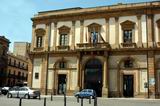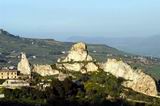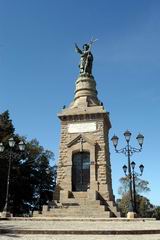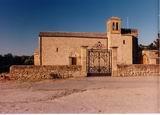 |
Caltanissetta Travel Guide |
| Situated in the centre of Sicily at a height of about 600 metres, Caltanissetta stands on the hump of a hill looking out over the island with a view ranging from Etna to the Madonie mountains and guarding in its bowels archaeological items and rare minerals. |
| Related images (9) |
|
The history The ideal centre of gravity of the island, it is at the meeting point of all the paths of communication between the main Sicilian meccas; it also has an original patrimony of its own in which there interweave art, archaeology, tradition and folklore. Its present-day name derives from the Arabic Qual'atan-nisa, that is to say “Castle of womoen”; actually its first names seems to have been pre-Arabic, as we know from ancient epigraphs, and subsequently it was integrated with Kastra and Kalactha to indicate the location of the town among the mountains. Thucydides narrates that in 427 B.C Nissa was a little town of Sicily garrisoned by the Syracusans. It was conquered in 123 B. C by Lucius Petilius, who called it Petiliana after himself. Then under Constantine it was annexed to the Eastern Empire, and afterwards it was conquered by the Aglabite Saracens, who called it Kastra-Nissa. Among the various elements upholding this thesis are the necropoles found at Gibil Gabib and Sabucina. The present-day town began to develop around the Saracen Pietrarossa Castle and in 1086, after the surrender of Girgenti (Agrigento), it was conquered together with other strongholds by the Normans, and its seigneur was Count Roger. Subsequently it came under the Hohenstaufens, the Angevins (Charles of Anjou, the brother of King Louis of France, invaded Sicily around 1260), the Aragonese, who made it a county (in 1282 the population rebelled against the tyranny of the Angevins, and called Peter of Aragona, the husband of Constance and a descendent of the Hohestaufens, to occupy the throne), the Castilians (Moncada Barons), the Austrians (in 1516 Charles V of Austria succeeded the Castilians by maternal right) and lastly the Bourbons in 1700. With the modern era, for Caltanissetta there began a period of decline which was to last until 1818, when it became the capital of a province; in 1844 it also became a diocese. A moment of great prosperity began in the early twentieth century with the exploitation of the sulphur deposits; Caltanissetta produced four-fifths of the world's sulphur and was indeed the world capital for sulphur. However, this position was challenged by American competition, which reduced its prosperity, and eventually led to the closing down of the mines. Today the “mine roads” can be a fine opportunity for cultural tourism, an imaginary bridge between the past and the present of this town, which looks to the future without ever forgetting its memorable past.
A walk in the town A walk through the town can begin at Piazza Garibaldi, historically the centre of Caltanissetta; in it two main streets meet, Corso Umberto I and Corso Vittorio Emanuele. The centre of the square is occupied by the Fountain of In the square there are various monumental buldings, the most important of which is the Cathedral, dedicated to Santa Maria La Nova and St. Michael; it was built in 1570-1622. It has a broad facade divided by pilasters; beside it there are two campalines (1840); there is a central pseudo-Baroque portal. A grandiose effect is produced by the central nave, decorated with stuccoes and with frescoes by the Flemish painter Wilhen Borremans in 1720. In the barrel vault there stand out three big compositions: the Immaculate Conception, the Coronation of the Virgin and the Triumph of St. Michael. In the second chapel on the right there is a fine wooden statue from the seventeenth century by Li Volsi, representing the Immaculate Virgin; it has drapes in silver foil. In the presbytery of the main altar there is a big altar piece by Borremans, “L'Immacolata e Santi”. On the right-hand wall there is a sumptuous organ with choir lofts and painted, inlaid and gilded panels, from the seventeenth century. In the left-hand part of the transept there is a Crucifix attributed to Brother Umile of Petralia. In the treasury there is a fine Gothic censer from the fifteenth century. Opposite the Cathedral there looms up the Chruch of San Sebastiano, which, according to the sixteenth century tradition, was built as a homage to the saint for ridding the town of the plague. Over the centuries the church was greatly altered and restored. In the last decade of the nineteenth century the new facade was done on design by the architect Pasquale Saetta. On the north side of the square, at the corner of Corso Umberto I, there is the Town Hall, which came into being on the ashes of the ancient church dedicated to Maria Santissima Annunziata, more commoly known at the Carmine, and the adjacent Monastery of the Barefoot Carmelites, founded in 1371 in what was an ancient hermitage outside the town walls. In the last century the Caltanissetta municipal authorities, after the suppression of the religious corporations, obtained permission from the government to use the former monastery buildings as a school, but then instead used it as the Town Hall, initially engulfing the church as the Town Hall chapel. Thus we come the Monument of Umberto I, a bronze statue by Tripisciano, and, further along, to the Sant'Agata al Collegio Church. Begun in 1605 by the Jesuits, the latter has an austere facade on a design by Natale Mesucci. The interior is in the shape of a Greek cross and is rich in marble inlays. At the back of the right-hand part there is the altar with the Madonna del Carmine with an altarpiece densely decorated with polychrome marble inlays. On the high altar, there is the “Martyrdom of Sant'Agata”, an altarpiece by Agostino Scilla (1654) in a frane of black marble surmounted by putti by Marabitti. At the back of the left-hand part the very rich altar is decorated with a big marble altarpiece by Ignazio Marabitti. One should note the magnificent inlays with dense and lively decorations showing birds amid exotic flowers, each distinguished with its own name. The first chapel on the left is decorated with frescoes by Luigi Borremans. The adjoining Jesuit College now houses the Municipal Library. Going through the picturesque Angeli district, which still has the medieval layout, you come first to the San Domenico Church, which was built in 1480 and enlarged in 1700. It has a fine curvilinear Baroque facade, and inside there are stuccoes and canvases by Paladino and Borremans. Continuing along Via San Domenico you come to the high rock on which there are the remains of Pietrarossa Castle, the only inland castle to be set in an urban context. It is of Arabic origin and bears witness to the new town settlement around the rock, once the Sabucina-Santo Spirito territory, in which people had settled in the pre-Christian era, was abandoned. The ruins of the castle, called “la murra di l'Ancili”, remind one of historic epoch which was very important for Caltanissetta, when it was a stronghold of medieval royal power, at the centre of a Sicily torn by struggles for supremacy. On an isolated rock rising steeply over a precipice, accessible only on the west side, the castle with three towers dominated the town below and the valley as far as the river Salso. There are numerous hypotheses about the origins of the castle; its name, which literally means “red stone”, is thought to be linked to the reddish colour of the ancient bricks which covered it. Since 1087 the castle was the theatre of outstanding historical vicissitudes which throughout the Middle Age made it a centre of political and military struggles, when Count Roger cinquered it. The Normans where succeded by the Hohenstaufens, and in 1925, after the Sicilian Vespers and the flight of the Angevins, the castle housed the conference of the Sicilian barons which proclaimed Frederick of Aragon King of Sicily. The castle suddenly collapsed on the night of 27 February 1567, perhaps because of an earthquake, leaving only one high isolated wall, a watch-tower in rough stone, bastions and a bridge. Adjoining the castle is the Church of Santa Maria la Vetere or Santa Maria degli Angeli, the second parish church of the town (after Santo Spirito), built in the thirteenth century. This church was closed in 1873 and went through a period of decay and abandon. We go back to the square and our walk continues along Via Regina Margherita, in which there is a succession of monumental buildings, including the Provincial Hall, and the Archbishop's Seminary, and ends in the Villa Amedeo public gardens. In the centre of the latter there is a circular-shaped fountain known as the “fountain of sighs”. At the end of the last century the garden was embellished with commemorative sculptures such as the half-bust of Vittorio Emanuele II (by Tripisciano) and the busts of Rossini, Bellini, Mazzini, Foscolo and Garibaldi by the San Cataldo sculptor Frattallone.
The surroundings Leaving behind the old centre and its monuments, we continue our walk, which is to provide other moments of great interest regarding history, art, culture and landscape, going first of all to the highest point in the town. Monte San Giuliano is a hill 728 metres high which dominates the town of Caltanissetta below, providing the vast and splendid panorama going from Etna to the Madonie Mountains and taking in the whole central part of Sicily. On 12 July 1899 this hill was chosen as the site for one of the twenty Monuments to the Redeemer which were to go up on twenty Italian mountains, one for each region, as an expression of faith. The pedestal of the monument, built in bossed local stone, is by the architect Basile. The monument consists of a crypt and of a chapel with a square base which takes on a circular shape at the top to form an adequate support for the bronze statue of the Redeemer making a hieratic gesture of blessing, while with is left arm he clasps the cross to his breast. There are annual events connected with both religion and tourism which make the Redeemer the symbol of a great tradition of art and religious folklore. Continuing our “journey” of discovery through this town we come to the Santo Spirito Abbey, immersed in a fascinating landscape which includes the valley of the Imera, Pietrarossa Castle, the profiles of Enna and Calascibetta and, on the clearest days, Etna in the background. It is the oldest church in the Caltanissetta province, having been built a long time before its consecration on 2 June 1151. Founded by Count Roger and his wife Adelasia, it is a Romanesque church in early Christian style, with three small apses divided by pilasters connected by little arches. In the lunettes of the portal one notices “Christ in the act of blessing”, a sixteenth-century fresco (actually, for security reasons and to avoid weather damage, the fresco in the portal is a duplicate of the original, which is kept inside); immediately to the right of the main entrance there is a Romanesque tub for baptism by dipping (this took place from the start of the Christianity until the twelfth century) and a Crucifix on a table from the seventeenth century. In the apse to the left of the arcade there is the epigraph referring to the consecration. In the sacresty there is an original Arabic arch, a little Roman urn and a tin chalice, the use of which was forbidden first in 220 and then, once and for all, by Pope Leo IV in the year 855. There are also paintings of outstanding artistic value, a sixteenth-century sedan chair and ancient sacred texts. Our itinerary ends with a dip into the past of the town. The Sabucina Mountain rises 660 in above sea-level and was chosen as a dwelling place by the ancients because of its strategic and defensive position. It is about eight kilometres west of Caltanissetta and, together with the Capodarso Mountain, dominates the Salso valley. At the foot of the mountain some necropoles from the early Bronze Age that there were small villages of the Castelluccio Facies. In the late Bronze Age, the summit and the slope were occupied by a vast prehistoric settlement with circular huts belonging to the Pantalica Facies (“tholos” shaped tombs); among the objects found are millstones and vases in various shapes, both coarse and processed. This area then remained uninhabited until the eight-seventh centuries B. C., when a new indigenous settlement arose on the slope of the mountain, which set up trade relations with the Greek colonies of Gela (the remains of the settlement bear witness to the existence of dwellings with a square layout, in which Greek material has been found as well as indigenous material).To the south-east of this dwelling there lay the sacred area made up of a circular chapel (it yielded the most important find, a little fictile temple) with a pronaos in front of it, polygonal columns and a Greek shrine with a rectangular layout. In the course of the sixt century B. C Sabucina was gradually transformed into a Hellenished place and then into a fortified centre of the Greek type (the material found in both the dwelling and the necropolis is Greek). During the Roman epoch the village of Sabucina came to life again at the foot of the mountain in Piano della Clesia, where there are ruins of a Roman settlement rich in houses with a great quantity of domestic ceramics and two important necropoles.
The museum The material collected is on display at the Archaeological Museum of Caltanissetta which houses the archaeological patrimony of the area and bears witness to the results of decades of work, excavations, studies and restoration concerning not only Sabucina, but also Gibil-Gabib, Capodarso and Monte San Giuliano in the Caltanissetta territory, Polizzello in the Mussolemi territory and Monte Bubbiona near Mazzarino. Caltanissetta also has other three museums. The Museum of Mineralogy , Palaeontolog and of Sulphur come into being strictly for teaching purposes and was in the Mineralogy School, which then became the Technical Institute. It was made open to the public in 1979 and houses minerals, rocks and rare and precious fossils, exemplars which are unique in the whole of Southern Italy. The Diocesan Museum of the Seminary, founded in 1987, which houses in its halls evidence of the sacred art in the diocese of Caltanissetta (among the works of art is the precious painting “Spasimo di Sicilia” attributed to Raffaello) and the Folklore Museum. In the museum the “Vare” are kept, groups of statues reproducing the Mysteries of the Via Crucis, done in the ninenteenth century by the Neapolitan sculptors Francesco e Vincenzo Biancardi; these sculptures are carried in a procession on Easter Thursday, which is the climax of an Easter tradition handed down over the centuries and intact, thanks to the wholehearted religious partecipation of the populace.
The province The territory of Caltanissetta, the heart of a precious alternative Sicily with a precise identity of its own as a hilly place going from the inland areas of the “Vallone” (gib valley) as far as the Gela coast, offers, in a rich palette of colours, a variegated simphony of landscape and climates. Caltanissetta province still presents a polyedric range of cultural aspects of interest to the tourist, such as works of art and architecture, archaeology, handicraft and folklore.
The rustic civilization Tidily lined up, the desks seem to await the pupils. Hanging on the wall, sickles and rudimentary tools await the agricultural labourer. A 'naca' (cradle) hangs from the ceiling over the parents' bed, waiting for the mother to rock it with a rhythmical and knowing gesture, calming the child in it. Although to our eyes, used to the most amazing technologies, they seem terribly obsolete, we cannot help recognising that the objects of the rural and domestic civilization of a hubdred or more years ago have a charm of their own, giving the idea of a familiarity that seems to drown in the floods of the remotest times but actually still belongs to us and links us to the life of our forefathers. In Caltanissetta province, various towns and villages have set up little museums containing objects linked to their rural past. One that stands out among them is Milena, where there are items relating to rustic civilization, the cycle of production of bread, flax, wine, corn and one can rediscover whole villages (“robbe”) perfectly conserved over the years, bearing witness to the very life of the Sicilian peasant. However, the other museums in the territory are not at all inferior: at Niscemi, in the museum named after Angelo Marsiano, there are 2000 items, from little children's toys to local craft products. Common to all these places is the opportunity to see the faithful reconstructions of the rooms in typical rural houses, mostly with one room. Thus at Sommatino or Marianopoli you can immerse yourslef in the atmosphere of the “good old days”. At Vallelunga, which has one of the richest museums of the kinf in Sicily, there are also reconstructions of craftmen's workshops, of an olive press and even an old schoolroom.
The mineway Continuing our ideal journey of discovery of the Caltanissetta territory we go along the “mineway” to discover the “sulphur civilization”, once connected with actual production in villages like Sommatino, Delia, Riesi and Montedoro, whose whole history is indeed indissolubly linked to sulphur. In 1834 there were no fewer than 196 sulphur mines concentrated in the central stretch of the island, 88 of them in the Caltanissetta territory alone. In that year there began a cyclic pattern market by moments of over-production with the consequent collapse of prices and the “stalling” intervention of foreign producers who, with their own deposits, determined the orientation of the market. The story of the mines is indissolubly linked not only to the economy of the area but also to the toil of the miners, “surfatara” and “carusi”. The crisis caused by the low prices of sulphur and to American competition on the market was reflected in the situation of the workers, already oppressed by less than uman living and working conditions, with wages which decreased all the time and with the costant threat of losing even that small pittance. The post-war years were deeply market by the drammatic struggles of the sulphur workers, bringing to the forefront the problem of their barbarous working conditions and that of the productivity of sulphur mining. This led to the setting up of the Ente Minerario Siciliano (Sicilian Mining Office), which should have attended to the reorganization of the mining industry and connected the latter with the chemical industry, thus linking mining to the overall economic development of the island and indeed the whole south; however, the attempt to stop the decline of the “mining civilization” failed. Nowadays the mines can provide a prestigious opportunity for cultural tourism, a journey in time and in the places which halped to leave a mark of civilization in Caltanissetta province. Toil, sweat, struggles, bitterness, successes, magically live once as one goes through the now deserted tunnels of the sulphur mines, silent and yet nonetheless efficacious witnesses of life and death.
The natural environment Those who want to know the Caltanissetta territory more deeply should not neglect its splendid resources in terms of landscape and nature, with outstanding opportunities for those who love trekking and hiking. Gela Biviere Lake The Biviere is the largest coastal lake and one of the few natural ones left in Sicily; it is located between the town of Gela and the mouth of the Dirillo River. This area gives shelter to many migratory ones that winter in Africa and nest in Europe. Sfondato Lake Located on a slope of Monte Pestichino ( in Mimiani territory), it is a pool of karst origin, small but very deep. A sheer rock wall, on which one can notice the contorted strata of gypsum, overlooks the lake. Contrada Scaleri Reserve Situated near Santa Caterina Villarmosa, is an interesting site for the study on the evolution of the surface karst morphology on different kinds of gypsum rocks on which water has carved peculiar grooves. Serradifalco Soprano Lake This is a little pool largely surrounded by a belt of reeds which formed recently, perhaps at the start of this century. This lake, which has a lacustral kind of vegetation, is fed mainly by rainwater. Monte Conca The wonderful landscape of great naturalistic interest presents some gypsum elevations, among which Monte Conca stands out. Both on the surface and in the underground appears the karst phenomenon, which has created two grottoes where a stream flows. Niscemi Cork-Oak Wood The Natural Reserve “Niscemi cork-oak wood” was established to protect the most important relic of cork and ilex oaks wood present in the centre of Sicily. The woods of Niscemi represent an example of forest-maquis with a majority of cork and ilex oak trees, where rare and interesting animals and various species of birds live. Mount Capodarso and the Imera Valley The southern Imera River, also known as Salso, which flows in the central part of Sicily south of the eastern Madonie Mountains, is the main river of the province.
Archaeology One can also follow the paths of history in inland Sicily, tracing out the march of Greek (and then Roman) colozination, which was interwoven with very ancient prehistoric indigenous cultures. The Hellenic civilization which, after the foundation of Gela by the Rhodians and Cretans in the seventh century B. C., sailed up from the southern coasts towards the inland part, along the Salso, did not meet rough indigenous nomads but a great urban settlement placed strategically on the hills dominating the course of the river – this was the Sabucina “Metropolis”. The hills Sabucina, Gibil Gabib and Capodarso were the sites of the towns of Sicans, then of the Greeks, and the “stationes” of the Romans, the last people to colonize this area. Vassallaggi, in the San Castaldo territory, can be seen as another testimony to Greek penetration in the inland area. The area of Sicilian civilization furthest inland, and perhaps the most ancient one, is in the Marianopoli territory. As far back as 3000 B. C., in the Castellazzo area there were settlements which grew bigger and bigger. Today in the whole area there crop up tombs and dwellings and a rich patrimony of vases, coins statuettes and household objects which point to the presence of a big achaeological area spreading out on the hills of Mimiani, Polizzello, Recattivo and Castel Bilici. The southern area of Gela province, towards the inland part, between Mazzarino and Piazza Armerina, also has a rich archaeological patrimony. From a historical and archaeological point of view, Gela is certainly a destination to privilege: founded by settlers from Rhodes and Crete in the 7th century B. C., it was one of the most important city-states of Magna Grecia. This florid period in its history is reflected in the items at the small but rich archaeological museum, which indeed has a big quantity of items documenting the whole period of human in the territory, from the first settlements before Greek colonisation down to the destruction of the city in 282 B. C. The museum, recently restructured and set out in accordance with the most modern display criteria, is on two floors. On the lower one there are significant architectural elements referring to the temple of Athena, the goddess who was the protectress of the city, which was on the acropolis. There are also statuettes and cult objects imported from the mother country. Numerous objects refer to the skill of Gela craftsmen and the flourishing trade that the town did with a great many place in the Mediterranean. There are objects recovered underwater, as well as three hundred pieces, containers for foodstuffs, vases and other objects, that scholars consider to be of exceptional value. Among the latter, a special mention goes to the “monetier” (coin collection) a true treasure of coins covering a period lasting from the VI century B. C to the Boubon seignoury (XIX century). The coins were stolen about 30 years ago and then found again: there are almost 2000 and they are exposed in a apposite hall, the central part of which is reserved for the silver late-arcaic coins. On the upper floor there are objects referring to the extra-urban sites, sanctuaries, necropolies and villages from the prehistoric age down to the Middle Ages. Recently the Gela archaic altars were exhibited in Paris, in one of the halls at the Louvre. Near the museum, you can visit the arcaeological zone, where diggings have brought to light the temple of Athena mentioned before, workshops and houses, a thermal plant and, above all, a stretch of city wall: the Capo Soprano fortifications have remained intact for a lenght of about three hundred metres under the sand and now constitute one of the most significant examples of military architecture. Mazzarino, with the two archaeological area of Sophiana and Monte Bubbonia, ends our itinerary among the paths of history in search of ancient civilizations still partly shrouded in mistery.
Folklore Losing oneself in the beauty of places which have down intact through the centuries suggests a further opportunity of discover unspoilt by the wear of time: the traditions linked to religious folklore guarded and handed down to our own day in all communes in the province. All these communes, indeed, conserve a rich tradition of celebration of rites for Easter Week. Texts, music, dirges, handed down from father to son, live sacred representations, revivals of ancient local folklore and religious traditions defy time, setting up every year a magic bridge past and present, folklore and religion, the crowd and the individual prayer.
Handicraft Concluding our journey into the heart of our province we cannot miss out the last piece in this varied, colourful, original mosaic: handicraft. A harmonious balance between what was and what is still pulsates in the original creative vein of handicraft. The fine embroideries of Santa Caterina and San Cataldo, for example, blend perfection of execution with a centuries-old and inimitable tradition.
TEXTS AND PHOTOS ARE PROPERTY OF A.A.P.I.T. OF CALTANISSETTA And again, the natural or enamelled terracotta products, created and decorated individually using techniques and colours handed down from generation to generation, symbolize a province which looks with great interest to the future without ever forgetting or denying the link with its past, its history, its traditions, its roots. | |
 |
Search other Guides |

 Munch: The Scream Within
Munch: The Scream WithinOne of the year’s most eagerly awaited exhibitions to open its doors on 14 September 2024: Edvard Munch is back in Milan with a major retrospective after a 40-year absence.
 In the garden
In the gardenThe initiative, which is scheduled to run from June 26th to September 13th, 2020, is inaugurating a temporary space for art in Corso Matteotti 5, in Milan, in the very heart of the city.
 Perugia Travel Guide
Perugia Travel GuidePerugia is the chief town of Umbria. This beautiful town is sited on a hill in the middle of a verdant country. His central square is considered one of the most beautiful squares of Italy and history, traditions, art and nature make a unique ensemble in this town as in the whole



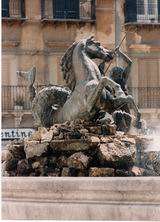 Triton, a bronze group representing a horse held by a triton disturbed by two marine monsters; this statue was done by the architect Gaetano Averna in 1956 on a cast of famous mythological groups by the Caltanissetta artist Michele Tripisciano.
Triton, a bronze group representing a horse held by a triton disturbed by two marine monsters; this statue was done by the architect Gaetano Averna in 1956 on a cast of famous mythological groups by the Caltanissetta artist Michele Tripisciano.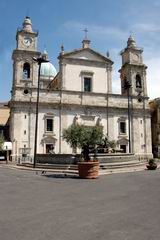 In the courtyard there are plaster models of the jurisconsults Paolo and Ortensio by Tripisciano, done in travertine stone for the Court of Justice in Rome. To the left of the Town Hall there looms up the grandiose Palazzo Moncada, which looks out on Salita Matteotti. Built in 1635-38 for Don Luigi Guglielmo Moncada, Viceroy of Sardinia and Sicily and Count of Caltanissetta, it remained unfinished because of lack of funds or maybe because Don Luigi was transferred to Spain. A summa of Sicilian Baroque, it has monumental exterior architectonic shapes and grandiose interior spaces; it also has big ledges in the shape of anthropomorphic figures, perhaps a catalyzing symbol of the power of the seigneur. The palace, whose imposing walls are two metres thick, was begun on a design by Brother Pietro of Genoa, a Capuchin friar, using architectonic reliefs and stones taken from Pietrarossa Castle and sandstone from Mount Gebel-Gabib. Starting from 1819, for one hundred and fifty years the palace was used as a Court, the Assize Court, the Royal Attorney's Office and the District Attorney Office; the interior of the building suffered a lot from the major alternations made to adapt it to its new functions. There remains still an underground tunnel (known as “u trabuccu”) which came out near trhe Capuchin Monastery in Viale Regina Margherita and began from the prison below the palace. According to tradition, those who were not in favour with the seigneur disappeared in it. We continue our walk along Corso Umberto I, in which there are various moumental mansions, such as Palazzo Giordano, Palazzo Canelotti, Palazzo Bordonaro, and so forth.
In the courtyard there are plaster models of the jurisconsults Paolo and Ortensio by Tripisciano, done in travertine stone for the Court of Justice in Rome. To the left of the Town Hall there looms up the grandiose Palazzo Moncada, which looks out on Salita Matteotti. Built in 1635-38 for Don Luigi Guglielmo Moncada, Viceroy of Sardinia and Sicily and Count of Caltanissetta, it remained unfinished because of lack of funds or maybe because Don Luigi was transferred to Spain. A summa of Sicilian Baroque, it has monumental exterior architectonic shapes and grandiose interior spaces; it also has big ledges in the shape of anthropomorphic figures, perhaps a catalyzing symbol of the power of the seigneur. The palace, whose imposing walls are two metres thick, was begun on a design by Brother Pietro of Genoa, a Capuchin friar, using architectonic reliefs and stones taken from Pietrarossa Castle and sandstone from Mount Gebel-Gabib. Starting from 1819, for one hundred and fifty years the palace was used as a Court, the Assize Court, the Royal Attorney's Office and the District Attorney Office; the interior of the building suffered a lot from the major alternations made to adapt it to its new functions. There remains still an underground tunnel (known as “u trabuccu”) which came out near trhe Capuchin Monastery in Viale Regina Margherita and began from the prison below the palace. According to tradition, those who were not in favour with the seigneur disappeared in it. We continue our walk along Corso Umberto I, in which there are various moumental mansions, such as Palazzo Giordano, Palazzo Canelotti, Palazzo Bordonaro, and so forth.